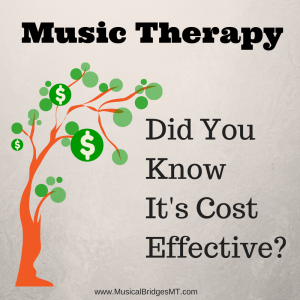 Let’s face it. Therapy is expensive. Especially if you don’t have insurance, then it’s a whole other realm of expensive. Fortunately, music therapy doesn’t have to be unobtainable to those who truly will benefit from it. Though insurance reimbursement for music therapy is a tricky subject at this point in time, there are reasons why music therapy should be considered by facilities. Hospitals, hospices, rehabilitation clinics, schools…. the list could literally continue with places that would not be hurting their pockets to hire a music therapist.
Let’s face it. Therapy is expensive. Especially if you don’t have insurance, then it’s a whole other realm of expensive. Fortunately, music therapy doesn’t have to be unobtainable to those who truly will benefit from it. Though insurance reimbursement for music therapy is a tricky subject at this point in time, there are reasons why music therapy should be considered by facilities. Hospitals, hospices, rehabilitation clinics, schools…. the list could literally continue with places that would not be hurting their pockets to hire a music therapist.
Music therapy is cost effective because…
Not only the person being treated reaps the benefits. The great thing about music is its aural qualities. Not only can everyone involved hear the music, but with live music sometimes the music can actually be felt (i.e. vibrations from strings of guitar or playing of a drum). Simply by listening, effects are taking place. By adding a trained music therapist the music can become more powerful as it is manipulated to create desired therapeutic effects for the patient. Though the music is designed and directed by the music therapist for a specific patient, aural effects are still taking place for those around the patient. Perhaps a family member or staff member is present. By passively participating (listening), they too may encounter physical or emotional changes brought on by the music. Often times when I work on the oncology floor at the hospital there are comments made by family members and nurses about how they now feel more energized, relaxed or uplifted. This is such a great quality that music therapy has, because when family and staff are happy and feeling good, this helps create a positive atmosphere for the patient and in turn helps boost moral for those working around the patient and their families.
Multiple treatment goals can be addressed at once– This plays off of the previous explanation of how music has effects even when they aren’t specifically being targeted. Let’s imagine a person who has been assigned to physical therapy. They have been depressed since their accident and become socially isolated, leading to poor therapy attendance. The patient is referred to a new facility where music therapists work alongside the physical therapists and are part of an interdisciplinary team so to maximize rehabilitation. After a few sessions the patient is well on their way to rehabilitation, experiencing less depression and beginning to attend regularly. Though the purpose of therapy was to work on physical rehabilitation, the patient’s emotional and social deficits were also addressed. By combining music therapy with physical therapy, the individual was able to express themselves through their musical selections and work towards physical goals at their chosen pace due to the luxury of the live music provided by the therapist. The non-invasive atmosphere in the therapy session also provided comfort and familiarity as well as the musical component adding an element of fun and motivation. This is just one example of how music therapy can aid in addressing multiple goals at once, so just imagine how many possibilities there are!
Multiple people can be treated at once– This is one of my favorite reasons! Music is easily seen as a group process. Whether it be groups listening or performing, music has brought people together since the beginning of time. Group therapy can offer opportunities for multiple patients to be treated while only costing a small individual fee. The more people in the group, the smaller the fee, and if a facility is providing the service then the participants get FREE services! For example… if a therapy group cost 75$ per hour and 15 people are signed up. That’s only 5$ a person! And it’s a music therapy group so you get to play instruments, listen to music, and be creative all while working towards therapeutic goals! Even better is when the facility provides the service and patients receive treatment at no cost. For example, when working at the hospital I receive a flat hourly rate. On average I treat about 7 people for every hour I work, which comes in highly cost effective for the hospital who is paying for the treatment.
So don’t be too quick to write off music therapy from your list of possibilities. Even if individual therapy isn’t in your budget, there are ways to make it cost effective for everyone. As time progresses, more and more facilities will take on music therapists as the profession grows and the benefits are seen.
2 Responses to #MusicTherapy: Did You Know It’s Cost Effective?!